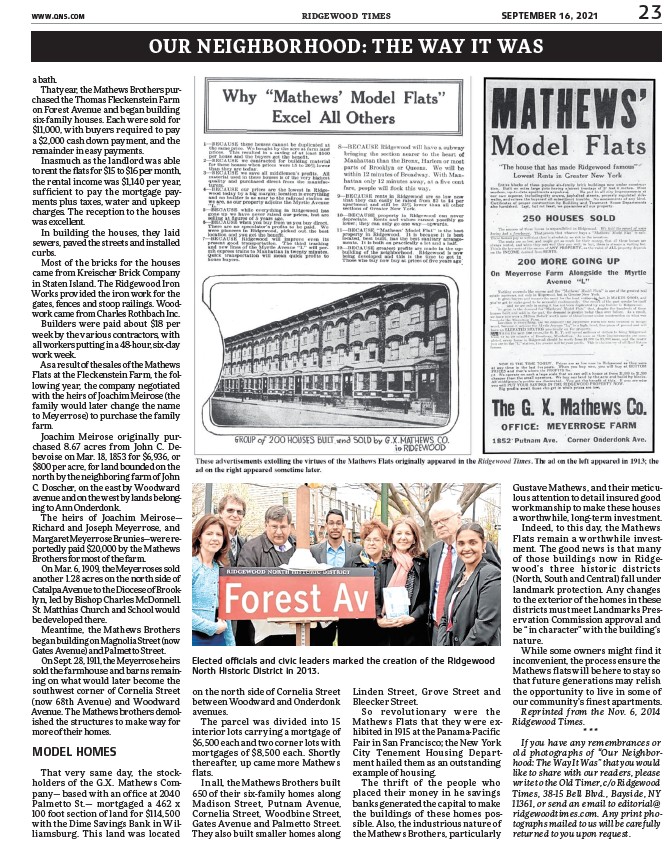
WWW.QNS.COM RIDGEWOOD TIMES SEPTEMBER 16, 2021 23
OUR NEIGHBORHOOD: THE WAY IT WAS
a bath.
That year, the Mathews Brothers purchased
the Thomas Fleckenstein Farm
on Forest Avenue and began building
six-family houses. Each were sold for
$11,000, with buyers required to pay
a $2,000 cash down payment, and the
remainder in easy payments.
Inasmuch as the landlord was able
to rent the fl ats for $15 to $16 per month,
the rental income was $1,140 per year,
sufficient to pay the mortgage payments
plus taxes, water and upkeep
charges. The reception to the houses
was excellent.
In building the houses, they laid
sewers, paved the streets and installed
curbs.
Most of the bricks for the houses
came from Kreischer Brick Company
in Staten Island. The Ridgewood Iron
Works provided the iron work for the
gates, fences and stoop railings. Woodwork
came from Charles Rothbach Inc.
Builders were paid about $18 per
week by the various contractors, with
all workers putting in a 48-hour, six-day
work week.
As a result of the sales of the Mathews
Flats at the Fleckenstein Farm, the following
year, the company negotiated
with the heirs of Joachim Meirose (the
family would later change the name
to Meyerrose) to purchase the family
farm.
Joachim Meirose originally purchased
8.67 acres from John C. Debevoise
on Mar. 18, 1853 for $6,936, or
$800 per acre, for land bounded on the
north by the neighboring farm of John
C. Doscher, on the east by Woodward
avenue and on the west by lands belonging
to Ann Onderdonk.
The heirs of Joachim Meirose—
Richard and Joseph Meyerrose, and
Margaret Meyerrose Brunies—were reportedly
paid $20,000 by the Mathews
Brothers for most of the farm.
On Mar. 6, 1909, the Meyerroses sold
another 1.28 acres on the north side of
Catalpa Avenue to the Diocese of Brooklyn,
led by Bishop Charles McDonnell.
St. Matthias Church and School would
be developed there.
Meantime, the Mathews Brothers
began building on Magnolia Street (now
Gates Avenue) and Palmetto Street.
On Sept. 28, 1911, the Meyerrose heirs
sold the farmhouse and barns remaining
on what would later become the
southwest corner of Cornelia Street
(now 68th Avenue) and Woodward
Avenue. The Mathews brothers demolished
the structures to make way for
more of their homes.
MODEL HOMES
That very same day, the stockholders
of the G.X. Mathews Company—
based with an office at 2040
Palmetto St.— mortgaged a 462 x
100 foot section of land for $114,500
with the Dime Savings Bank in Williamsburg.
This land was located
on the north side of Cornelia Street
between Woodward and Onderdonk
avenues.
The parcel was divided into 15
interior lots carrying a mortgage of
$6,500 each and two corner lots with
mortgages of $8,500 each. Shortly
thereafter, up came more Mathews
flats.
In all, the Mathews Brothers built
650 of their six-family homes along
Madison Street, Putnam Avenue,
Cornelia Street, Woodbine Street,
Gates Avenue and Palmetto Street.
They also built smaller homes along
Linden Street, Grove Street and
Bleecker Street.
So revolutionary were the
Mathews Flats that they were exhibited
in 1915 at the Panama-Pacific
Fair in San Francisco; the New York
City Tenement Housing Department
hailed them as an outstanding
example of housing.
The thrift of the people who
placed their money in he savings
banks generated the capital to make
the buildings of these homes possible.
Also, the industrious nature of
the Mathews Brothers, particularly
Gustave Mathews, and their meticulous
attention to detail insured good
workmanship to make these houses
a worthwhile, long-term investment.
Indeed, to this day, the Mathews
Flats remain a worthwhile investment.
The good news is that many
of those buildings now in Ridgewood’s
three historic districts
(North, South and Central) fall under
landmark protection. Any changes
to the exterior of the homes in these
districts must meet Landmarks Preservation
Commission approval and
be “in character” with the building’s
nature.
While some owners might find it
inconvenient, the process ensure the
Mathews flats will be here to stay so
that future generations may relish
the opportunity to live in some of
our community’s finest apartments.
Reprinted from the Nov. 6, 2014
Ridgewood Times.
* * *
If you have any remembrances or
old photographs of “Our Neighborhood:
The Way It Was” that you would
like to share with our readers, please
write to the Old Timer, c/o Ridgewood
Times, 38-15 Bell Blvd., Bayside, NY
11361, or send an email to editorial@
ridgewoodtimes.com. Any print photographs
mailed to us will be carefully
returned to you upon request.
Elected offi cials and civic leaders marked the creation of the Ridgewood
North Historic District in 2013.